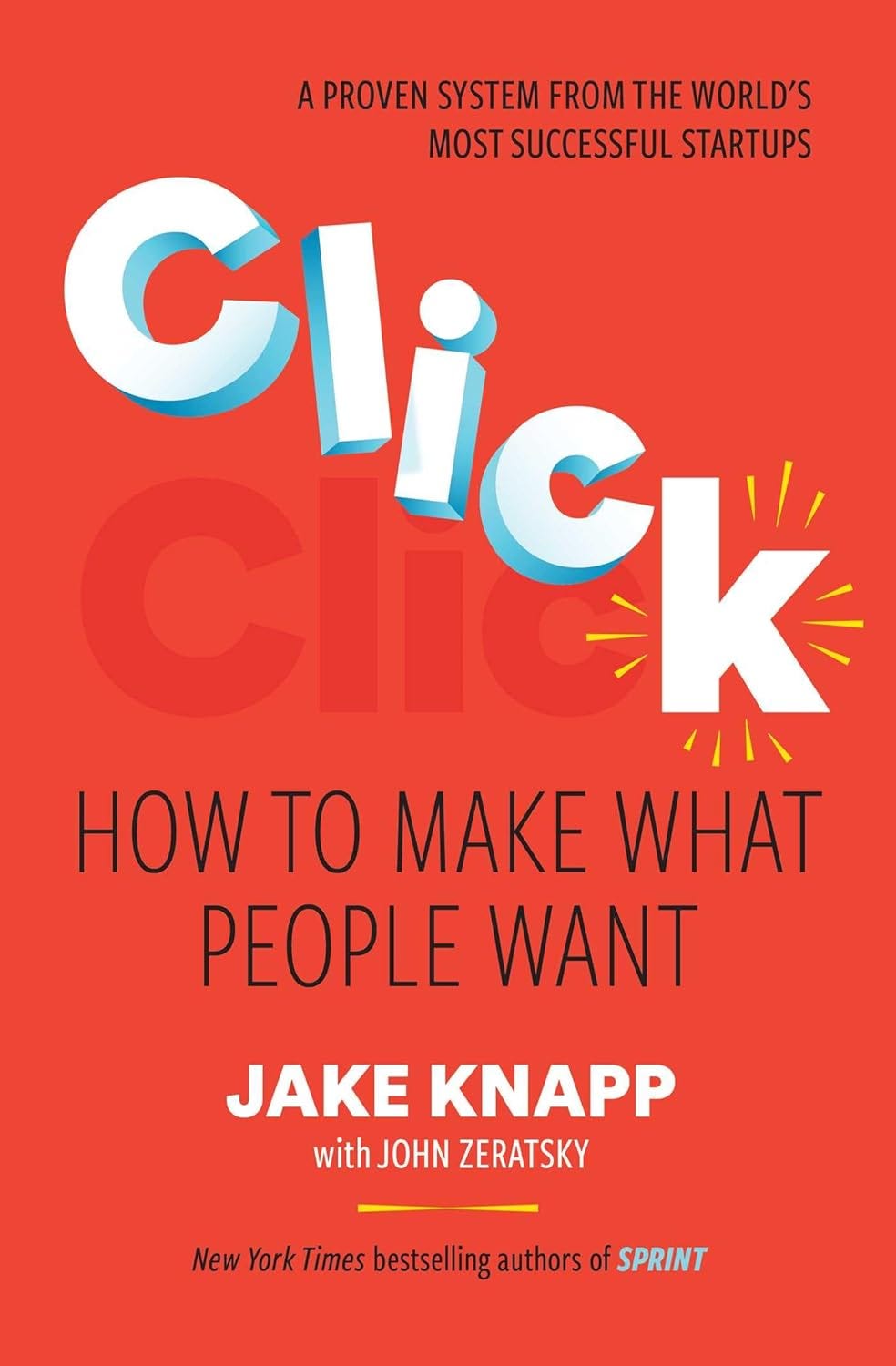Hola! Welcome to BigIdeas.FM - we bring you conversational podcasts and sexy newsletters curated from world’s best and latest non-fiction books.
Today, it’s time to Click, the latest book on startups by designer-authors who have been involved in Google ventures as well as many successful products. Btw, the book was released a week back - and it's available on BigIdeas.FM. Become a premium subscriber if you haven't :) Every big project—whether it’s creating new technology, developing a fresh line of sneakers, or opening a neighborhood café—requires a major investment to get off the ground. Unfortunately, most big projects flop with customers.
Too many teams waste time, money, and opportunity because they follow the wrong strategy and lose sight of what really matters:
Do people want what you’re making? Does your solution click with customers?
Jake Knapp and John Zeratsky—two brilliant product designers who spent years at Google Ventures and elsewhere before founding a venture capital firm together—have helped hundreds of teams bring new products and services into the world. As designers and investors, they have a front-row seat to some of the world’s most successful startups.
Click introduces the Foundation Sprint—a proven system for starting projects the right way, to make better decisions and move quickly toward a solution.
Inside are ten important lessons, a step-by-step playbook for the Foundation Sprint, and memorable stories from Nike, Google, Slack, and the frontiers of artificial intelligence research. Building on their bestselling book, Sprint, Knapp and Zeratsky introduce new recipes that teams can use to quickly and confidently start projects. For anyone who has ever had a good idea but didn’t know how to start, this book is for you.
Making Ideas Click: How to Validate and Adapt Your Product Strategy with Speed
Making Ideas Click: How to Validate and Adapt Your Product Strategy with Speed
Building a new product is challenging, and most new products unfortunately flop rather than click with customers. This failure can be a colossal waste of time and energy. While many factors contribute to success, the most important is whether the product and the customer fit together – whether it "clicks". A product clicks if it solves an important problem, stands out from the competition, and makes sense to people.
Often, teams get caught up in the details of technology, execution, and design, losing sight of the fundamental question: When this is offered to people, will they want it? All too frequently, teams bet on the wrong strategy, leading to failure.
The traditional approach involves spending months or even years building and launching a finished product before discovering if customers actually want it.
Even building a Minimum Viable Product (MVP) for an ambitious solution can take about a year . This slow, risky path makes adaptation difficult if initial assumptions are incorrect.
However, there is a more reliable way to increase the chances of success. A system has been developed and proven, based on firsthand experience with successful products at companies like Google and numerous startups. This system helps teams clarify fundamentals, make rapid decisions, and set up fast experiments to figure out what clicks. It centers around using sprints to create, test, and adapt a product strategy based on real customer feedback.
The system begins with a Foundation Sprint. This is a two-day workshop designed for a team at the beginning of a big project. Its purpose is to quickly create clarity on the project's fundamentals. On day one, the team defines the Basics: who the target customer is, the problem to solve for them, the team's unique advantages, and the strongest competition. They then craft their differentiation – what makes their solution stand out – and practical principles to guide decision-making. On day two, the team explores multiple possible approaches to the solution using a method called Magic Lenses, which helps them consider competing opinions and perspectives visually. The process utilizes techniques like Note-and-Vote and working alone together to streamline discussions and decision-making. The Foundation Sprint requires intense focus, necessitating the team to call a "time-out" from normal distractions like constant meetings and email. Getting the "Decider" – the real boss who can make decisions stick – involved from the start is crucial.
The output of the Foundation Sprint is a Founding Hypothesis. This is a clear statement condensing the team's fundamental guesses about the customer, problem, approach, and differentiation. It's simple but powerful, like a compelling promise to customers. Crucially, the Founding Hypothesis is just a guess until proven. It's a tool for learning, intended to be tested, proven wrong, and updated.
This is where the Design Sprint comes in. Design Sprints are the recommended method for testing and adjusting the Founding Hypothesis. It's a five-day process that allows teams to solve problems and test new ideas.
Monday: Map out the customer problem.
Tuesday: Sketch competing solutions on paper.
Wednesday: Decide which solutions to test.
Thursday: Create realistic prototypes.
Friday: Test with customers.
The Design Sprint provides a "time machine" effect, allowing teams to see customer reactions to a prototype before investing in building the full solution. This allows for rapid experimentation using "tiny loops" between the hypothesis and customers. Instead of long development cycles, teams get multiple attempts to make their solution click.
Design Sprints can be used to prototype and test various aspects of the strategy, not just software. Teams can focus on testing key risks. Often, the first Design Sprint focuses on testing the product's story – how customers discover, learn about, and decide to try it, perhaps using a sales deck or website prototype. This helps validate if they are reaching the right customers, if the customers have the problem, and if the differentiation appeals to them.
A key advantage of Design Sprints over building an MVP is the ability to test multiple competing prototypes simultaneously. Teams can try different ideas head-to-head. Testing prototypes against competitors or the status quo provides valuable realism . Observing genuine, unguarded customer reactions to prototypes offers vital signals. If a prototype clicks with most or all testers, it's a strong indicator of potential product-market fit.
This system allows teams to iterate rapidly. If a prototype doesn't click with customers, the team adjusts their ideas and repeats the sprint process. These early adjustments, even if they involve changing the solution or modifying the Founding Hypothesis itself (like the target customer or differentiation), are seen not as failures but as "hyperefficient pivots" [conversation history, based on 114]. Pivoting when prototypes don't click takes hours, compared to months when an MVP fails.
By starting with a Foundation Sprint to form a clear hypothesis and following with consecutive Design Sprints to test and adjust it, teams radically increase their velocity. They prove (or disprove) their foundational guesses and adapt based on real customer interaction before investing significant time and money in building the final product. This system helps teams get closer to making a product that people actually want. Examples include companies like Phaidra testing an AI dashboard prototype or Genius Loci testing website+signs against an app concept, using this approach to validate their strategies and adapt based on customer feedback. Many successful companies and startups have used or adopted these methods to bring products to market.










